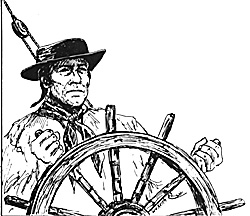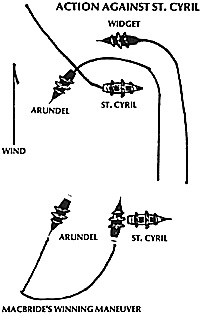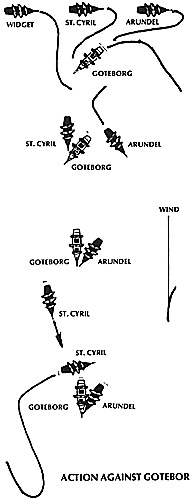 Although most miniature gamers aren't interested in role-playing per se,
many gamers use elements of roleplaying in their campaigns. Many
Napoleonic enthusiasts paint their victories on their regiments' colors
(maintaining a fictional honors list seems like roleplaying to me), and
gamers of every sort maintain various period aliases through whose
characters they experience the clash of combat - even going so far as to
give themselves promotions, knighthoods, and courts-martial depending
on their performance in the game. My own confederate general Albert
Sidney Greenstreet has participated in a number of stirring miniature
campaigns against his archenemy George Brinton McFudd - and what
reader of The "old" COURIER can forget the astonishing Gluteus Maximus?
Although most miniature gamers aren't interested in role-playing per se,
many gamers use elements of roleplaying in their campaigns. Many
Napoleonic enthusiasts paint their victories on their regiments' colors
(maintaining a fictional honors list seems like roleplaying to me), and
gamers of every sort maintain various period aliases through whose
characters they experience the clash of combat - even going so far as to
give themselves promotions, knighthoods, and courts-martial depending
on their performance in the game. My own confederate general Albert
Sidney Greenstreet has participated in a number of stirring miniature
campaigns against his archenemy George Brinton McFudd - and what
reader of The "old" COURIER can forget the astonishing Gluteus Maximus?
The following is an excerpt from an historical campaign and features two naval battles interlinked by roleplaying elements. The rules used were my own PRIVATEERS & GENTLEMEN, with HEART OF OAK being used for tactical combat and PROMOTIONS AND PRIZES for the details of roleplaying. it should be emphasized that this is a battle report, not a description of a roleplaying game, but that the battles herein described are part of a much larger, ongoing campaign in which the roleplaying element provides a vital part.
Death MacBride was played by Jon Williams; Orville McNeish was played by Sean Kane. The referee and scenario designer, William Chasko, played the Russian and Swedish forces.
 Scenario Start
Scenario Start
In July of 1755, the 18-gun ship-sloop ARUNDEL, Commander Angus Macintosh, was ordered to the Baltic to "take, burn, or destroy" enemy shipping in support of His Britannic Majesty's Prussian allies. ARUNDEL had been to the Baltic once before, to deliver arms shipments to the rebel Prince of Lithuania; much of the success of that particular episode, resulting in the capture of a Russian brig, being due to ARUNDEL's energetic First Lieutenant, Death MacBride.
ARUNDEL was also to be accompanied by the three-masted schooner WIDGET, of 12 guns, under Lt. Orville McNeish, his first cruise in a capacity of command. The two British men of war were both swift sailers, possessed crack crews, and were in the restricted waters of the Skagerrak within a few days after hoisting anchor at the Nore. It was decided to take the passage through Denmark's Great Belt to avoid facing the Swedish batteries near Malmo, which had proved troublesome during the previous voyage.
Off the friendly port of Lubeck, Macintosh's small squadron caught sight of the Russian 32-run frigate ST. CYRIL. The brave Macintosh immediately determined to attack, hoping that his well-drilled crews would make up for the Russian's heavy preponderance of armament. Atthe price of a few Gaelic expletives, ARUNDEL and WIDGET were cleared for action, and, with the wind behind them, bore down on the Russian frigate. ST. CYRIL at first made off eastwards, presumably to lure the British deeper into the Baltic, and then luffed up to start firing a series of irregular broadsides at long range.
 The actual maneuvering of ARUNDEL was left by Macintosh to Lt. MacBride, who, Macintosh admitted, possessed skills the Commander lacked. Macintosh's participation in the battle was limited to bellowing out aggressive, if vague, commands such as "Don't fire until you smell the rum on their breath!", which MacBride was then obliged to interpret.
The actual maneuvering of ARUNDEL was left by Macintosh to Lt. MacBride, who, Macintosh admitted, possessed skills the Commander lacked. Macintosh's participation in the battle was limited to bellowing out aggressive, if vague, commands such as "Don't fire until you smell the rum on their breath!", which MacBride was then obliged to interpret.
ST. CYRIL's repeated inept broadsides had failed to do much other than chip some paint from ARUNDEL's figurehead, and MacBride did not bother yawing to reply. He reserved his first fire, nine tripple-shotted guns, for a point-blank bow-rake of the Russian ship, an astoundingly successful maneuver that brought ST. CYRIL's foremast and mainmast crashing into the briney. With the foremast gone, ST. CYRIL could no longer head into the wind, and began to fall off slowly, unable to maneuver.
MacBride luffed, and brought ARUNDEL along ST. CYRIL's port broadside, answering gun for gun, taking a pounding from ST. CYRIL's twelvepounders. Here Commander Macintosh was struck by a Russian round shot, tearing off his left arm, and was carried below. Lt. MacBride was now entirely on his own.
ST. CYRIL continued to fall off from the wind, and MacBride brought ARUNDEL across the helpless Russian's stern, giving her another tripleshotted blast that brought her mizzenmast down in splinters and torn canvas. The Russian was helpless, wallowing broadside to the wind, one of her sails, fallen across a hot gun, afire. The Russians beat out the flames, but ARUNDEL judiciously backing and filling, kept lying off her stern, pounding raking broadside after raking broadside into ST. CYRIL's helpless posterior.
WIDGET, unfortunately, had failed to support ARUNDEL adequately during the early stages of the battle. Lt. McNeish duplicated MacBride's maneuver of crossing the Russian's bow, but failed to close the range, so that WIDGET's first broadside was, to put it charitably, not as effective as it could have been. WIDGET continued to duplicate MacBride's maneuvers, but at a longer range, making a lazy circle far downwind. ST. CYRIL's big twelve-pounders found WIDGET even at fairly long range, though, and in a continuation of the sudden mania the gods of war seemed to have developed for seeing masts fall, completely dismasted the little British schooner.
Fortunately WIDGET's help wasn't needed. MacBride continued to pour broadsides into ST. CYRIL, which was trying, with some desperation, to rig a jury mast and bring her broadside to bear. MacBride decided it was time to end the contest.
Filling his sails, he beat upwind, then tacked. Tacking is a dangerous maneuver to perform in a battle, but the ARUNDEL's crack crew performed without a hitch, and brought the sloop downwind across ST. CYRIL's stern at the range of a few yards, firing its triple-shotted unengaged broadside into the already-shattered stern. Grapples were flung, locking the ships together in a position where ST. CYRIL could not possibly reply, and the jury mast was battered down. Having no real choice, ST. CYRIL surrendered.
At the close of the battle, Lt. MacBride was informed that Commander Macintosh has died of shock following his wound. MacBride was now Acting-Commander, not only of ARUNDEL, but of a dismasted prize and a dismasted friendly schooner.
Fortunately Lubeck was nearby. WIDGET rigged jury masts, and ARUNDEL took ST. CYRIL in tow, and Lubeck was made the next day, to a thunderous reception from its Prussian occupants. A few Russians, rather than rot in Prussian jails, volunteered to serve in His Majesty's Navy, and a few drafts of Prussian seamen were sent aboard. WIDGET was fitted with new masts in a few weeks, but no new masts could be found of a size to fit ST. CYRIL. Topasts were fitted in place of the lower masts, but ST. CYRIL, now under Lt. McNeish's command, would remain a slow vessel.
Second Battle
July and most of August were spent repairing ST. CYRIL and getting her ready to return to England. The crews of the ships were distributed as well as MacBride could arrange, and with a 32-gun Prussian frigate as escort, and a blind-drunk Danish pilot, the little flotilla began to beat up the Great Belt.
WIDGET was run aground during the five-day passage of the Belt, and though it was got off without any trouble it leaked badly, causing the pumps to be manned throughout the rest of the voyage. The Prussian frigate and the Danish pilot bade MacBride adieu as they entered the Skagerrak, and the little British flotilla commenced its homeward journey, against the prevailing Westerly winds, towards home.
The morning of the second day the Skagerrak had not yet been cleared, and, as the sun rose behind it, the topsails of another ship were visible on the eastern horizon. As the other ship continued to tack towards them, the British recognized it as an enemy: GOTEBORG, a Swedish 32-gun frigate, the showboat of the Swedish Navy, said to be the best-manned ship in the Baltic. ARUNDEL had narrowly escaped GOTEBORG during her previous voyage in the Baltic, but now, with the slow ST. CYRIL preventing them from running away, and with the whole day before them, the British had no hope of escape. And GOTEBORG showed no signs of a wish to decline combat.
 With GOTEBORG five miles off and gaining rapidly, MacBride heaved his ships to and made hurried plans. Most of WIDGET's remaining crew were taken into ST. CYRIL to keep her guns manned. Their fire would be slow, but it was to be hoped that the twelve-pounders would be more effective than WIDGET's little popguns. Ten men, under a bosun's mate known for his suicidal bravery, were left aboard the schooner. MacBride swore that by the day's end, His Majesty would either have two new frigates, or Death MacBride would rest in Davy Jones' arms.
With GOTEBORG five miles off and gaining rapidly, MacBride heaved his ships to and made hurried plans. Most of WIDGET's remaining crew were taken into ST. CYRIL to keep her guns manned. Their fire would be slow, but it was to be hoped that the twelve-pounders would be more effective than WIDGET's little popguns. Ten men, under a bosun's mate known for his suicidal bravery, were left aboard the schooner. MacBride swore that by the day's end, His Majesty would either have two new frigates, or Death MacBride would rest in Davy Jones' arms.
MacBride's plan was to form his fleet in a line, ARUNDEL in the lead, WIDGET in the rear. Sailing under easy sail at ninety degrees to thewind, they would open fire at long range and keep pelting GOTEBORG with dismantling shot during the Swede's approach, hoping to knock down a critical mast or spar. If GOTEBORG lost its headsails or driver, it would be unable to beat upwind towards the British, and MacBride could then escape. Failing this, or if the Swede were somehow badly crippled, the British could then sail downwind and attack. One of the British vessels (WIDGET, with any luck, or ST. CYRI L if WI DGET failed) would try to foul the Swedish ship, grappling it to hold it in place, while ARUNDEL hung off GOTEBORG's stern and kept raking it until it was forced to strike.
No plan that neat could possibly succeed. GOTEBORG took only minor damage as it approached, although a few lucky shots resulted in twenty Swedish marines being flattened and killed the Swede's second lieutenant. When GOTEBORG beat to within close range, the British squadron wore around and opened fire with their fresh larboard broadsides, receiving Swedish iron in return. WIDGET, narrowly missing its attempt to ram GOTEBORG, received a full broadside for its pains and lost its rudder; it sailed off downwind, and was unable to make its way back into the action until all was over.
ARUNDEL and ST. CYRIL both engaged GOTEBORG's port side, giving and receiving destruction. ST. CYRIL managed to collide with the Swede, planting its bowsprit in GOTEBORG's mizzen shrouds, but its attempt to grapple failed and GOTEBORG cut free, but not before ARUNDEL luffed up around its stern and raked it.
The three ships travelled parallel, GOTEBORG sandwiched between ARUNDEL and ST. CYRIL, trying (rather inefficiently) to man both broadsides. ARUNDEL's wheel was shot away, and MacBride was forced to steerwith the sails. MacBride determined upon a desperate strategy; he would increase sail, forge ahead, and cross the Swede's bow, hoping to force the Swede to collide in a position that would allow ARUNDEL to rake GOTEBORG from hell to breakfast.
The maneuver was a half-success. ARUNDEL picked up speed and swing across GOTEBORG's path, but GOTEBORG managed to turn at the last minute and when their bowsprits crossed, both broadsides were still bearing on one another. MacBride's maneuver also caught McNeish in ST. CYRIL by surprise, and ST. CYRIL, the wind behind her, sailed rather absent-mindedly out of the action - in order to return, ST. CYRIL would have to turn into the wind and beat up to the fight, a long process.
So for the moment it was ARUNDEL vs. GOTEBORG, ARUNDEL's broadside of nine nine-pounders versus sixteen Swedish twelves. The ships were locked together in such a position as to preclude boarding; both sides kept their cannon going in furious exchanges. Critical hits flew thick and fast. ARUNDEL lost her fore topmast. GOTEBORG lost a section of guns. ARUNDEL was holed repeatedly at the waterline, and MacBride was forced to divert men from the guns to man the pumps. Soon ARUNDEL seemed to be visibly settling in the water. GOTEBORG's mainmast crashed thunderously over the side. Both ships were set afire, but the fires were quenched.
The Swede's preponderance of armament was telling. ARUNDEL was slowly being beaten to fragments. MacBride gloomily contemplated some desperate strategy, such as setting fire to his own ship and hoping the Swede blew up with her.
But then rescue arrived, in the form of the tardy Lt. McNeish and ST. CYRIL! The ex-Russian swept up alongside GOTEBORG's blind side, its guns sweeping the Swedish decks. Forty Swedish crewmen hit the planks. ST. CYRIL swung around GOTEBORG's stern and drifted slowly down into the Swede, its guns firing as fast as McNeish's crew could load and fire. The Swedish captain was killed, and the heart went out of his crew. GOTEBORG struck her colors, and was boarded by MacBride's disbelieving crew. ARUNDEL was clearly sinking. Her crew evacuated onto GOTEBORG, and fifteen minutes after the end of the action, ARUNDEL went down with all flags flying.
The Scottish village of Scarborough, some six days later, was amazed to find two frigates entering the harbor, one an ex-Swede and the other an ex-Russian, the White Ensign floating boldly over the colors of Sweden and Russia, accompanied by an equally-battered British schooner. Pandemonium struck England at the double victory: MacBride and McNeish, both Gaels, were given a proper Scots welcome as they progressed southward to deliver their respective reports. His Britannic Majesty George II really had no choice after that; but even so his Hanoverian voice trembled a bit as he raised his dubbing sword and pronounced the ominous sounding phrase, "Arise, Sir Death".
The first battle, ARUNDEL vs. ST. CYRIL, was a classic engagement between small ships, in which superior crew quality and handling almost completely negated a heavier broadside. A lot of critical hits were rolled, and almost all of them were mast hits; two out of the three vessels engaged were dismasted.
The second battle was more atypical, chiefly because the British had only two crews to distribute among their three ships, and also because of the many critical hits rolled, only one applied to a mast. All things considered, the British tactics were the best they could have come up with under the circumstances. They were lucky in that most of their critical hits were applied to the Swedish crew, which tended to whittle the Swedes down to size.
Both sides, in both battles, handled their sails well; the British in particular, fighting the ST. CYRIL, kept backing sail off the Russian's stern in order to continue their deadly rakes.
Death MacBride, now a Post-Captain, was to go on to greater things as the roleplaying game continued; this campaign was to chronicle the beginnings of his rise to power and pre-eminence among 18th Century commanders.
Back to Table of Contents -- Courier Vol. VII #2
To Courier List of Issues
To MagWeb Master Magazine List
© Copyright 1986 by The Courier Publishing Company.
This article appears in MagWeb (Magazine Web) on the Internet World Wide Web.
Other military history articles and gaming articles are available at http://www.magweb.com